Make Steam Great Again Trump Uss Gerald Ford
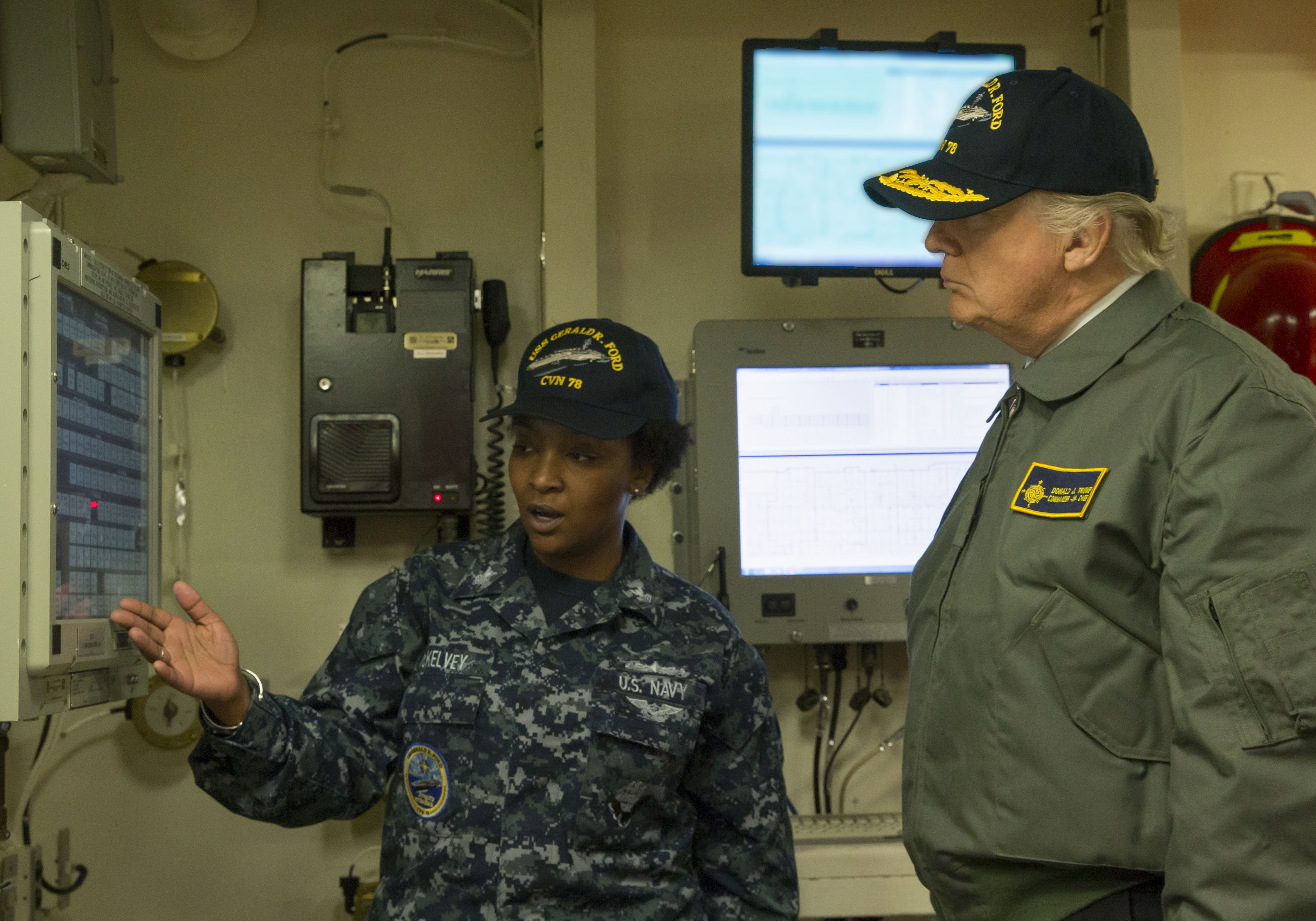
President Donald J. Trump tours Gerald R. Ford (CVN-78). Trump visited March 2 to meet with Sailors and shipbuilders of the Navy's first-in-course shipping carrier. US Navy Photo
This post has been updated to include a comment from Acting Navy Secretary Sean Stackley.
President Donald Trump wants the new Gerald Ford-grade aircraft carriers to use older steam catapults to launch shipping rather than the new electromagnetic launch system that the Navy has been developing for more than than a decade.
The unexpected comments from Trump came during a wide-ranging interview with Time magazine that were published on Thursday. Trump referred negatively to the "digital catapult organisation" – a reference to the Full general Atomics Electromagnetic Aircraft Launch System (EMALS) – and said it would take "Albert Einstein to effigy it out." Trump stated his preference for the Ford-class carriers to utilise the older Mk 13 steam catapult system that is used on the Nimitz-grade carriers and the French carrier Charles de Gaulle (R 91).
"Information technology sounded bad to me. Digital. They have digital. What is digital? And information technology's very complicated, you have to be Albert Einstein to figure it out," Trump said, according to the published interview.
"And I said – and at present they desire to purchase more shipping carriers. I said, what system are y'all going to be – 'Sir, nosotros're staying with digital.' I said, no y'all're not. [You're] going to goddamned steam, the digital costs hundreds of millions of dollars more money and it'due south no expert."
The Navy news desk declined to provide a comment on Trump'due south interview. Acting Navy Secretary Sean Stackley told USNI News Thursday afternoon that he would not annotate on the president's remarks themselves, but he added, "we have non briefed the president on the Ford program. He did become down to Newport News and visited the ship, was onboard the send. And then I wasn't present for that visit, I don't know what his source of information was."
A spokesperson for Ford-class shipbuilder Huntington Ingalls Industries referred questions on Trump's comments to the Navy. A Full general Atomics spokeswoman who works with the EMALS program as well referred questions on Trump'south comments to the Navy.
A spokesman for the National Security Council acknowledged a USNI News request for more information on Trump's intentions but has not yet provided additional clarity on the issue.
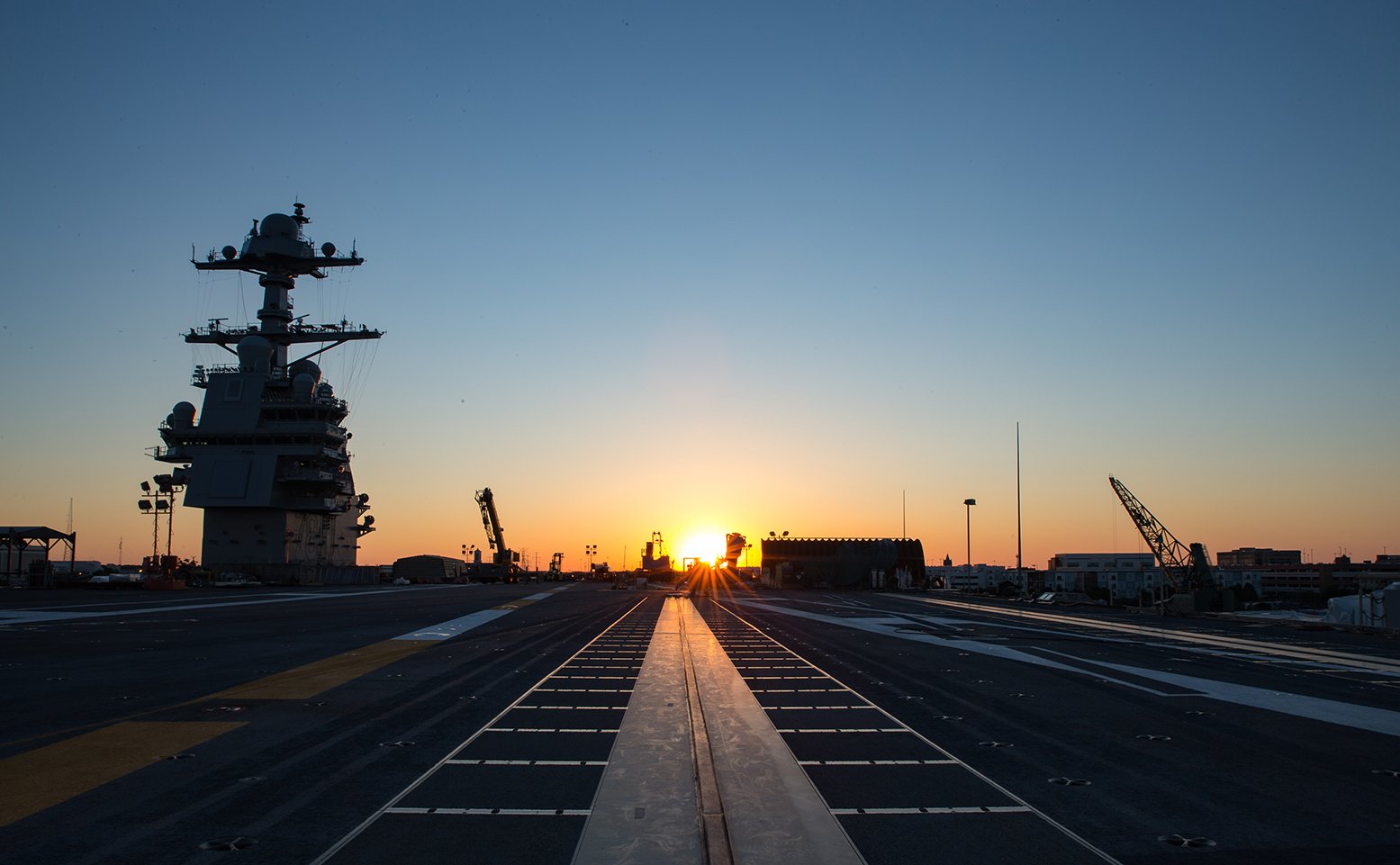
Gerald R. Ford (CVN-78), marker the beginning of a June day of Fast Cruise. Ford is conducting a three-day Fast Prowl to familiarize the coiffure with the ship's systems for an extended period of time on June 8, 2016. US Navy Photo
EMALS is already installed on Gerald R. Ford (CVN-78), and in 2015 the Navy began ownership materials for EMALS on the follow-on John F. Kennedy (CVN-79). In January, the service awarded a $527 1000000 contract to Full general Atomics for EMALS on the 3rd Ford-grade carrier, Enterprise (CVN-80).
While early EMALS development was challenging for the service and slipped in cost and schedule, the Navy has been a vocal supporter of the launching system in the last several years.
Information technology's yet unclear how much influence the president can have on previously fabricated decisions to use specific government furnished equipment in already agreed upon shipbuilding contracts.
The Mk 13 steam catapult used on Nimitz-class carriers is no longer in product, and if the service elected to render to steam launching it would likely have to design a new system, with the Navy incurring an unknown level of additional expense, USNI News understands.
From the transcript published by Time, it's unclear with whom Trump spoke about the EMALS system and when.
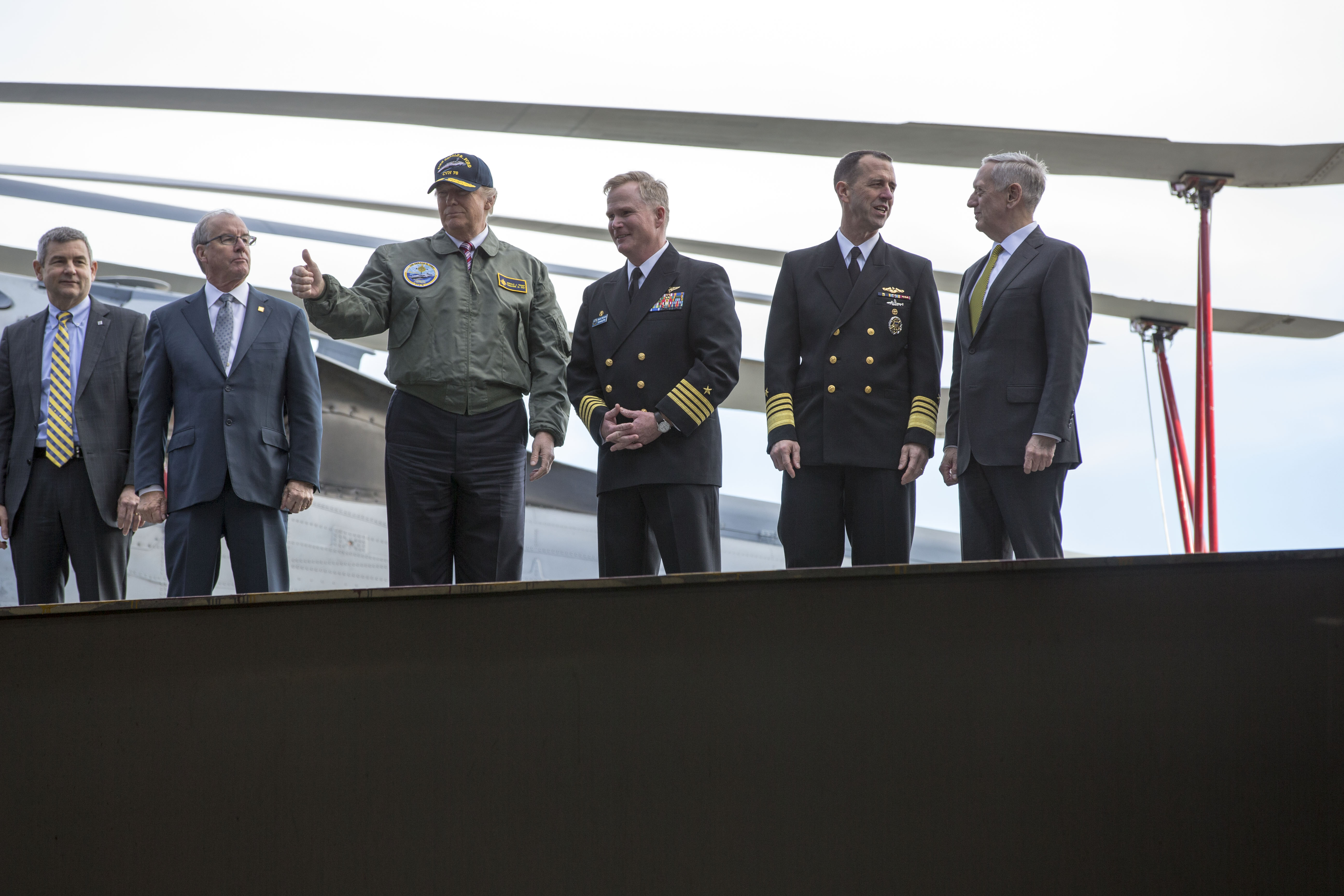
President Donald J. Trump gives a thumbs-up to the audience after his tour of Gerald R. Ford (CVN-78) on March 2, 2017. Standing with the president from left to right HII CEO Mike Petters, HII Chairman Tom Fargo, Ford CO Capt. Richard McCormack, CNO Adm. John Richardson and Secretary of Defence James Mattis. US Navy Photo
On March 2, Trump visited Gerald Ford, during which time he took a brief tour of the carrier and spoke with several members of the crew. Also aboard for the visit was Main of Naval Operations Adm. John Richardson, HII CEO Mike Petters, HII Chairman Tom Fargo, Secretary of Defence James Mattis and Ford'southward commanding officer Capt. Richard McCormack.
During the transition menstruation after the November ballot, Trump also met with Vice CNO Adm. Bill Moran, Naval Sea Systems Command commander Vice Adm. Tom Moore and interim Secretary of the Navy Sean Stackley to discuss, among other topics, Ford-class evolution.
EMALS Development
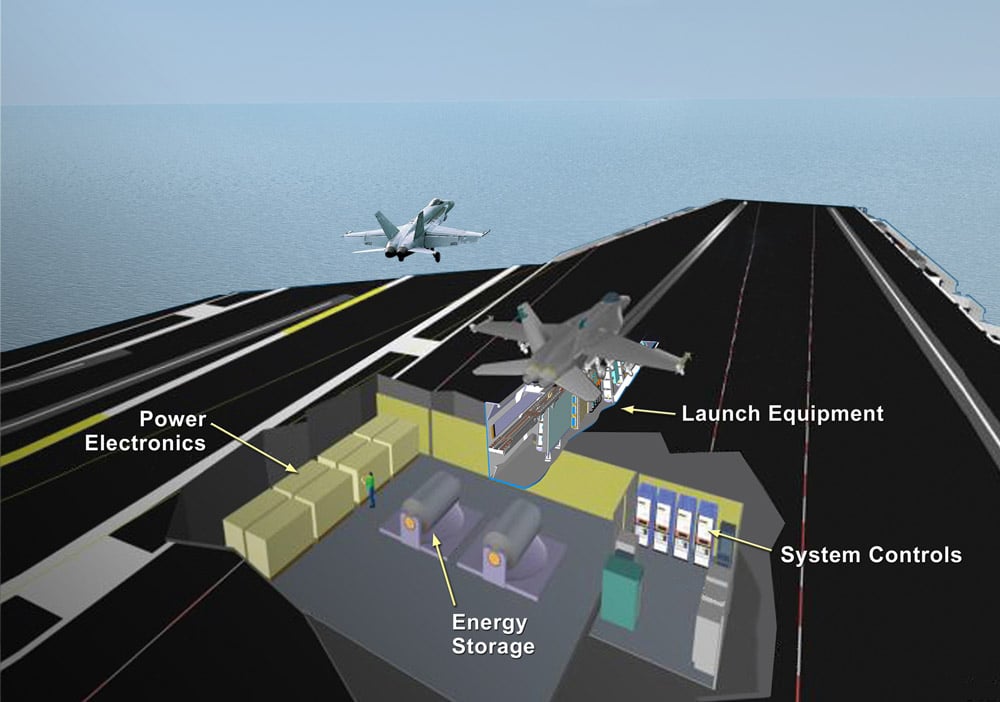
An creative person'south conception of the electromagnetic launch systems (EMALS). General Atomics Photo
The Navy's decision to innovate three new major warfighting systems into the Ford form has proved a controversial one, but of the three – EMALS, the Advanced Arresting Gear and the Dual-Band Radar – EMALS by all accounts appears to be the biggest success.
Moore, the electric current NAVSEA commander who previously served as the Programme Executive Officer for Aircraft Carriers, lumped the 3 technologies together in 2013 when discussing cost overruns. He told reporters that rising costs of the iii major systems accounted for twoscore percent of the overall price overruns for the showtime-in-classGerald R. Ford, though he did not break that downwards betwixt EMALS, AAG and DBR.
In June 2015 the Navy awarded Full general Atomics $737 million for long lead materials for the EMALS and AAG systems for the second Ford-class carrier,John F. Kennedy. Moore said at the fourth dimension that "everyone knows we had some significant price overruns on EMALS and AAG" in the lead ship but that "I recollect what you'll find on CVN-79 is we've gotten that cost under control."
Despite early challenges, Moore and others were thrilled with the system's performance one time it made it through land-based testing and was installed aboardFord for shipboard testing.
"For the get-go fourth dimension in over 60 years, nosotros've just conducted 22 no-load test shots using electricity instead of steam applied science," Moore said in May 2015. Once EMALS started dead-load testing – where EMALS catapulted hunks of metal designed to mirror the weight of diverse aircraft types – Moore called EMALS "probably one of the best news stories in the (carrier) program" and said the system "worked similar a champ" during early expressionless-load testing.
The system did run into its share of failures during testing – including a case of "unfortunate timing" when the shipbuilding team brought reporters out for the first public EMALS demonstration in June 2015 and the organization failed due to communications issues amidst components, despite working the day earlier and then working again afterwards that afternoon later the press had left. Those challenges were chalked up to growing pains, and by a twelvemonth later then- CVN-78 course programme managing director Capt. Chris Meyer told USNI News that the entire drove of examination data proved EMALS was more reliable than had been predicted.
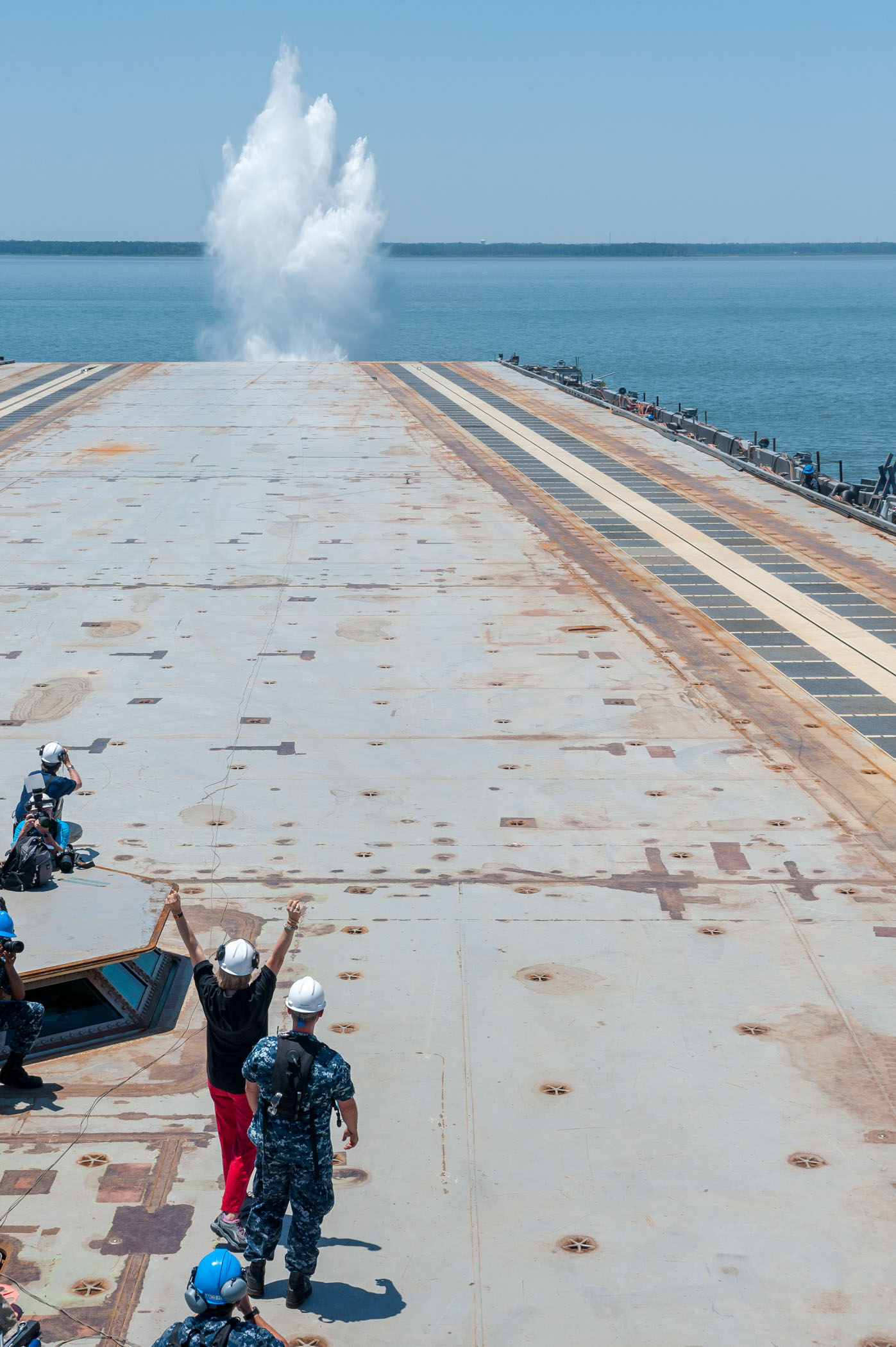
Dead load launched from Gerald R. Ford (CVN-78) during EMALS testing. HII Photo
Notwithstanding, in Baronial 2016 the Pentagon called for a 60-day review of the unabridged Ford-form carrier program, to include a focus on five systems, including EMALS. The Pentagon memo cited "the lack of sufficient reliability growth demonstrated to date and the ability to support both surge and sustained aircraft operations" as the reason for a review of EMALS, despite Navy statements that cost had since stabilized and reliability was better than expected.
Ultimately, for the Navy, EMALS represents more than than simply a new way of launching airplanes. Steam catapults put a lot of stress on the airplanes getting shot off the front of the carrier, and therefore the planes have to be congenital sturdy plenty to withstand those pressures – which means they end up being heavy. Every bit a upshot, Moore and then-Managing director of Air Warfare Rear Adm. Michael Manazir explained in 2015, any engineer trying to design a future naval aircraft will end up with a design similar the F/A-18 Hornet, the EA-18G Growler or the F-35C Joint Strike Fighter.
With EMALS, though, the electromagnetic field creates a smoother dispatch and doesn't bailiwick the aircraft to steam. Along with the new AAG, which refines how information technology stops an aeroplane based on its weight, "what it too does is open up … the envelope for lower-weight shipping. Then as we start exploring where we're heading with unmanned aircraft, information technology gives us a lot of flexibility from a warfighting standpoint that the (legacy system) doesn't," Moore said.
"Y'all can at present start to do things with aircraft blueprint that you couldn't do earlier. It might permit us some more margin in weight, in size, and in construction and capability," Manazir added.
The post-obit is the extract from the Time magazine interview on the subject of the Ford-class carriers.
On the future USS Ford-course carriers
You lot know the catapult is quite important. So I said what is this? Sir, this is our digital catapult system. He said well, we're going to this because we wanted to keep up with modern [technology]. I said you don't use steam anymore for catapult? No sir. I said, "Ah, how is it working?" "Sir, not proficient. Not good. Doesn't accept the power. You know the steam is merely brutal. You see that sucker going and steam's going all over the identify, at that place's planes thrown in the air."
Information technology sounded bad to me. Digital. They have digital. What is digital? And information technology'south very complicated, you have to be Albert Einstein to figure it out. And I said–and at present they want to purchase more than aircraft carriers. I said what arrangement are yous going to be–"Sir, nosotros're staying with digital." I said no y'all're not. You going to goddamned steam, the digital costs hundreds of millions of dollars more coin and it'southward no good.
Source: https://news.usni.org/2017/05/11/president-trump-wants-ford-carriers-use-goddamned-steam-catapults-instead-no-good-electromagnetic-launchers
0 Response to "Make Steam Great Again Trump Uss Gerald Ford"
Enviar um comentário